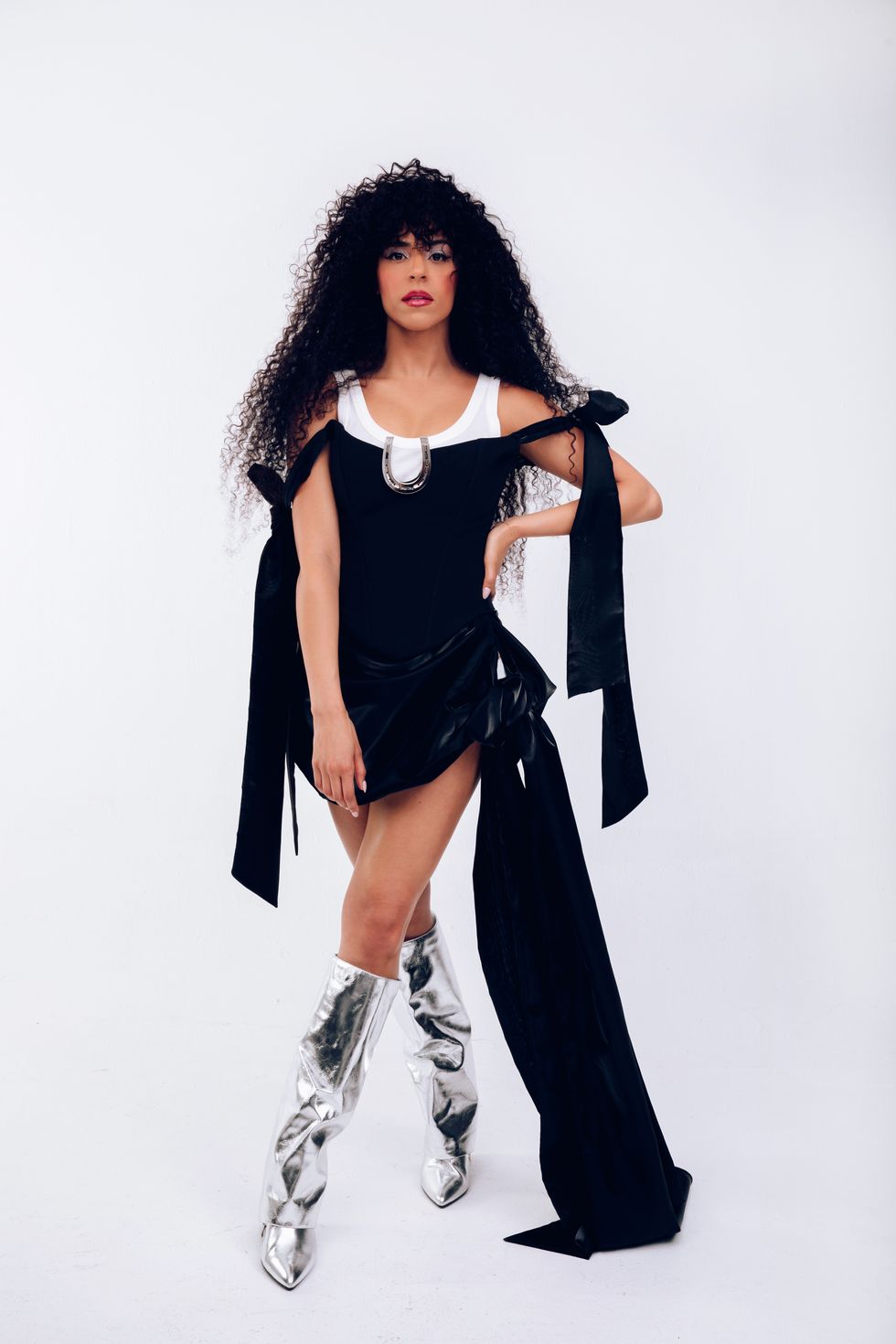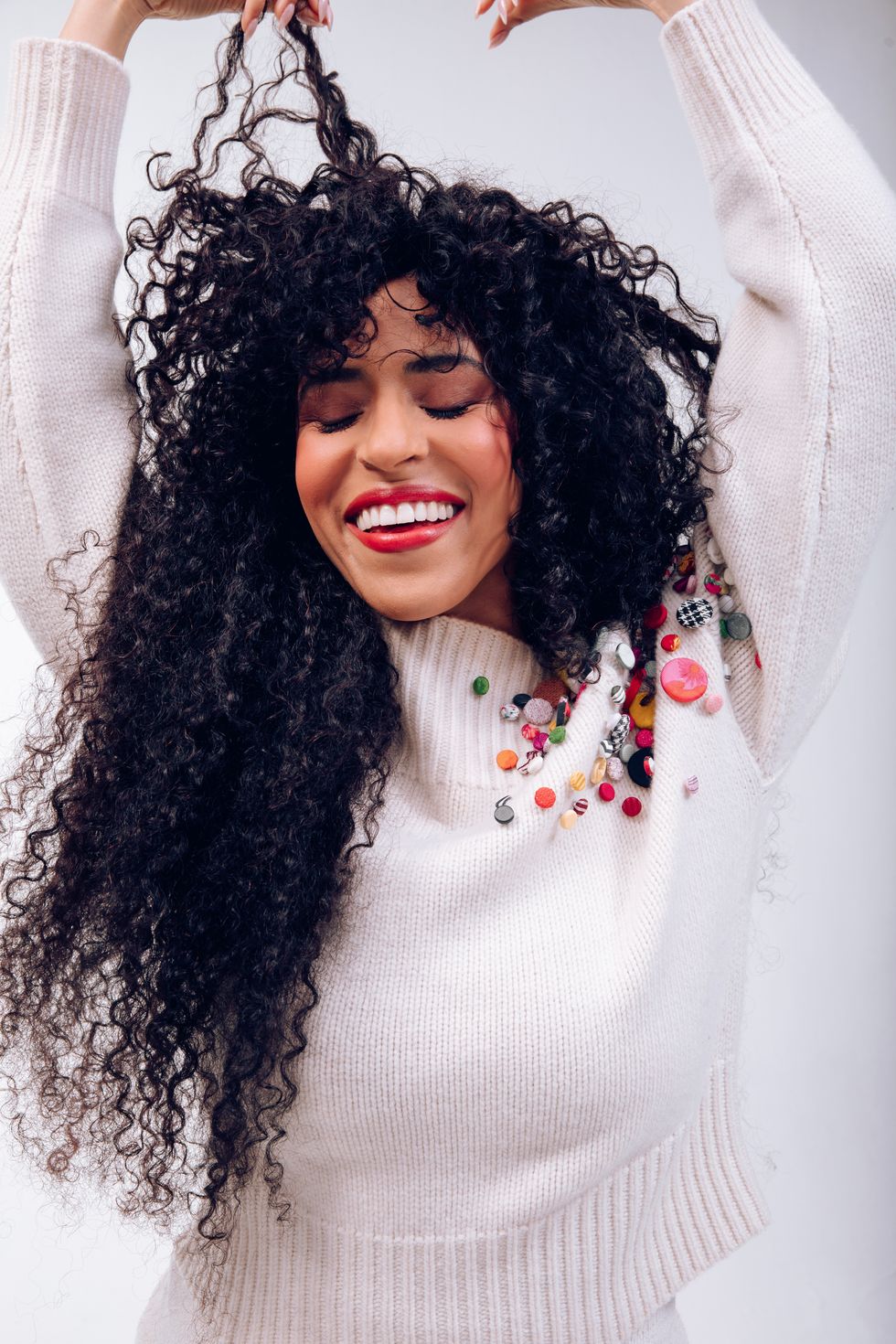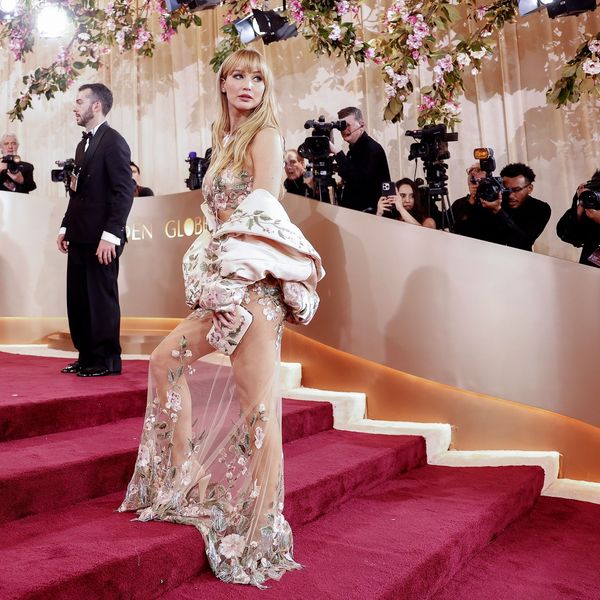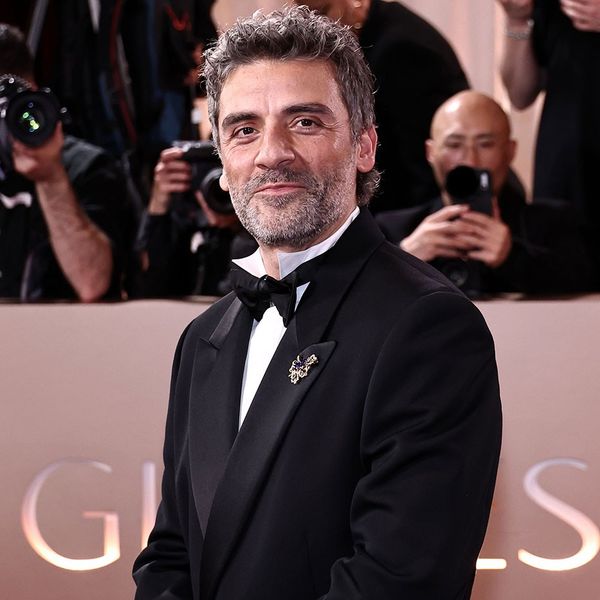Gavin Turek Is No One’s Sad Girl
Talking Donna Summer, girl dinner, and musical joy with the People’s Diva.

As I sign onto Zoom, I realize I’ve just committed a cardinal meeting error: taking a massive mouthful of my drink right before it’s time to speak. Gavin Turek—a disco dance-funk singer known for her exuberant live performances—signs in looking casual yet fresh, just in time to see me try to talk and instead choke. “I’m so sorry,” I splutter, “I’m just having my sad-girl lunch.” “Your what?” she asks. I show her my protein shake, and she laughs, “That’s not so sad!” She then shows me the protein bar she’s eating. We discuss the beauty of “girl dinner” and spend the rest of our conversation companionably eating our respective “girl lunches.” Hers, at least, has the very sophisticated addition of yellow kiwis eaten with a delicate golden spoon, which she inadvertently yet charmingly waves around like a wand as she speaks, punctuating her thoughts like an upbeat, glamorous wizard.
A longtime collaborator with artists like Tokimonsta and Mayer Hawthorne, Turek has a sophomore album, Diva of the People, coming out soon and a European tour on deck for this summer. I tell her I’ve been listening to her new single “IOU” nonstop since it came out the day before and that my husband and I have been adding her upbeat, modern yet nostalgic songs to all our summer playlists. She’s genuinely delighted, and it hits me how refreshing it is to see a seasoned artist still earnestly appreciating a new listener. I tell her about the influences we’ve guessed at and how my husband made me promise to ask if she was a fan of Evelyn “Champagne” King. As soon as she hears the name, she nods and wags her spoon approvingly. “Yes!” she says emphatically, “Of course. I love this reference. He knows!” We go on to spend the next hour talking disco, musical joy, and the supreme power of “not fighting it.”

Tank Top: Anine Bing; Dress: Esquina; Boots: Stylist's Own

Coveteur: Why disco?
Gavin Turek: “That’s a hard question to answer because I think I fell into it ignorantly. I knew the surface level of why anybody would be drawn to disco—the aesthetic of it, the hair, makeup, the dancing, Studio 54, Donna Summer. As a woman of color who has big hair, I fit naturally into that disco aesthetic and kind of fell into it that way.
Since I've been making music, it's been one big experiment of throwing a lot of shit at the wall and seeing what sticks and what resonates with me, seeing where my voice fits. And I realized, ‘Oh, wow, if I'm not fighting my voice, if I'm not fighting my look, if I'm not fighting the fact that I am a dancer and that when I perform, I inherently make people dance, then this is kind of where I end up: being influenced predominantly by this genre, in both an aesthetic and a musical way.’
After I established that inclination, I dove deeper into the history and what it meant politically. Black, brown, queer people made disco, and it was really for them. It was a reclamation of so many different things that were natural and organic to their communities that were initially established underground. After diving into the history, I was like, ‘Oh, yeah, it fits.’”
Has that initial inspiration evolved?
GT: “I released my first disco song in 2015 called ‘Don't Fight It,’ then did another song called ‘Frontline.’ They're probably the most stereotypically ‘disco’ songs I have. After that, I kind of was like, ‘Okay, I'm owning the look, I'm owning the aesthetic of this genre hard, and I really love it.’ I'm embracing that, but I was experimenting and still am. I really went hard into the funk and R&B part of the '70s with my last album.”
How about with this new album?
GT: “For this album, I was trying to get back to what was natural for me, what brought the most joy in the creation process, and I really wanted every song on this album to be very simple. I wanted to just make sure that I was bringing joy. And so again, where did I go? Disco. Disco’s just that girl for me.”

Sweater: Hellessy; Bottoms: Vintage; Boots: Stylist's Own

Do you think we’re at a particularly ripe cultural moment to bring more joy into music?
GT: “It feels like that, on an energetic level—like we need it, so maybe we're turning to it more. And that's what I felt when I was making this music. I made my sad girl album. I knew that I didn't want to do that again. Not in the sense of forcing myself to inauthentically tap into joy when I'm not feeling joyful. It was more like, I am joyful again. I have let go of a lot. I have moved on from things that were very, very heavy. I can breathe; I can embrace who I am, which is actually not mysterious. I'm not the sad, mysterious girl. I know that's really popular, and I kind of tried to do that for a second, but it's just not authentic to me.”
Right. ‘Sad girl’ is popular, but not everyone’s sad all the time or wants to be.
GT: “That's why I really admire people like Kylie Minogue and Diana Ross, who are consistently embracing and communicating joy and creating spaces that allow people to be really happy. They're human; they're not like that all the time, obviously, but you can tell it's authentic to them. And I think it's authentic to me. For me to be mysterious, it just doesn't work. I'm just not!”
I feel like I'm getting a theme of sort of purity of expression, which feels a lot like what we see in dance. How do you think that your dance background has influenced your music?
GT: “I guess the most obvious way that it has influenced me as an artist was when I studied abroad. I studied abroad for a year in Ghana and India and focused on dance. When I got back from Ghana, I felt like with that training and learning the dances particular to that region and how intense it was, I really had to put it all out there and not care about how I looked. It was just so different, completely out of my comfort zone. You're stepping into someone else's territory and learning humbly, learning someone else's dance that their ancestors have been doing for centuries. I can't remember the Ghanian term for a Gringo, but you're just coming in like, ‘Okay, I have a dance background, but not in this realm whatsoever.’ It doesn't really matter if you've had 10 years or more of training; you're at square one, and this is different and challenging in a whole new way. So by the time I came back, I felt like I had tapped into a new freedom of expression, and it really transformed the way I performed.”
Did that experience inspire you to incorporate dance into your performances?
GT: “It clarified that I had to dance in my performances. When I was singing in college, I was just kind of standing there. [This experience] made me feel like I could move in a way that was just more free and not typical of what I was seeing. My first shows that I have recorded, [I look like] I'm on steroids. It's like I'm an Energizer bunny shaking my ass. I'm insane. It's actually way too much.”


That kind of sounds amazing.
GT: “It got people's attention because it was different, and it just seemed like I didn't give a fuck. It seemed like I didn't care what people thought about me, and like I was tapping into this freedom of expression. But it needed to be refined a little bit because it was so raw. Now, it's evolved naturally. But yes, it was just a beautiful way to start my career as a performer and really say, ‘I can do this in a way that is authentic to me and is not how other people do it.’”
How was the process of creating your new album?
GT: “This album was so much fun to me. And that's not something to take lightly. A lot of albums are not fun. I remember seeing the Janet [Jackson] documentary, and she talks about my favorite album of hers, The Velvet Rope, and how painful that process was, how it was not all creative amazingness or whatever. Thank God, this album was the opposite. It was so fun and organic. I had hit a wall after my last album and just felt insanely insecure about my skills and what I brought to the table. I was also really, really struggling with moving on after a breakup. So that's where I was, and I was thinking to myself, ‘Man, I don't feel like writing music right now.’ So I turned to screenwriting, which ended up taking me on a solo trip to Italy.”
So “Eat, Pray, Love”!
GT: “I was gone for a month, and it was so beautiful. I thought about music, but I just didn't do anything having to do with music. I just ate and lived, and I wrote for something else, and it was just what I needed to reset. When I came back, I got back into the studio with a producer I had probably worked with only once before. It's really hard for me to branch out once I get comfortable with someone in a creative relationship. And so with this producer, it was like, ‘Ooh, this is a risk.’ Same with dating; it's very similar. You date different producers, and you're like, ‘Is this going to work? Are we going to have chemistry creatively or not?’ But with this particular producer, Spencer Ludwig, I just had a feeling that it was going to be fun and easy.”
Was it?
GT: “We ended up writing almost all the songs on the album in two months! Art of Tones also produced two of the songs and COR.Ece co-wrote ‘Disco Boots’ with me. It was very fast. I didn't second guess myself. All of the first ideas I executed. With the last album, we were rewriting constantly—which a lot of people do, and I'm not knocking that—but with this process, I just felt like trusting myself and trusting my first instinct with a lyric or with a concept. That was the intention I brought into it.
The other intention was to have songs that were so simple that after you listened to them just one time, you would know what they were about, and they would stick in your head. Everything needs to be simple, conceptually, and catchy in that way. I also wanted everything to have an element of movement and dance. So, most of the songs are 120 BPM and above. Oh, and every song was inspired by an awkward moment.”


Do tell!
GT: “I was dating for the first time as an adult adult, and going on apps and doing that whole thing. I didn't know what I was doing. I was making so many mistakes; I was just so awkward. I didn't really know how to interact with these guys. I was like a baby in the streets, and I felt like everybody knew it. I would come to the studio with one story after another of me not knowing how to handle a situation with dating. So, a lot of the songs are from those types of experiences. Instead of being sad about making a fool of myself, I just decided to make fun of myself.”
I love that this was a fun, joyful process and is a joyous album, but it came from these awkward moments.
GT: “Oh, yeah. That's why this album is called Diva of the People. Because it's that juxtaposition that we all have. It's that binary opposition within all of us of being really fabulous and terribly awkward at the same time or being confident but being insecure. All of those elements are always playing with me. I either look like this, or I look like Donna Summer. I have no in-between.”
Speaking of Donna Summer, your music evokes a lot of retro, nostalgic vibes while feeling modern. Do you feel more like you’re updating the oldies or adding nostalgic elements to contemporary music?
GT: “I think because the foundation is nostalgic, we're going to lean on that, and a lot of times that’s actually through melody. I really, really love writing songs that sound like you've heard them before. I don't want to reinvent the wheel. That's really important to me. For this new album, the goal was to create melodies that were both nostalgic and unfamiliar in nature. I like hearing songs on the radio that are like, ‘Oh, this synth is so soothing because I feel like I've heard it before. This chord progression is soothing because I've heard it before.’ That's beautiful.”
That's kind of what melody is in the first place. We enjoy it and it's satisfying to us because it's predictive.
GT: “I like being predictable! A lot of writers don't; they just want to blow your mind. They just want to surprise you. Every four bars—bam! Something new. And I don't want that. I want to be predictable. I want you to follow and understand what I'm saying. That's just where I'm at, because I did it the other way for a while.”
What else do you want for this new album?
GT: “I would love for all kinds of people to listen to it. It's definitely for the girls and the gays, obviously, but also, your husband was liking it. I hope it's a universally appealing body of work because it's joyful and it's nostalgic. I hope people, young and old, can appreciate it and feel the joy. I hope they feel that I had a lot of fun creating it. Music obviously carries energy, and it's more impactful than I think any of us believe. So, after making an album where I felt the energy was a little bit darker and heavier, I'm hoping that my darkness didn't transfer onto somebody else. I want to make sure that the energy that is received from this is light and joyful, because I know how powerful music is.”
I think that’s what we need. Over the last few years, we’ve all been to some dark places that I don’t think we need to revisit.
GT: “We sure did, and we do not need to return to them. That's not my purpose in this world. Maybe someone else’s—but not mine.”
Style Editor: Camille Freestone / Art Director: Smiley Stevens / Managing Editor: Hilary George-Parkin / Casting Director: Yasmin Coutinho / Executive Producer: Marc Duron
Want more stories like this?
Welcome to the Bridal Boom
Hollie Bowden Has Mastered the Unexpected
Elizaveta Porodina Finds Limitless Expression in Photography




